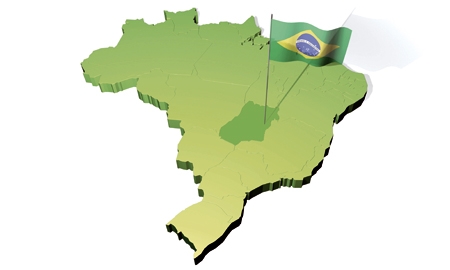
On entering office as Brazil’s first female leader on January 1, 2011, President Dilma Rousseff pledged to build on the progressive socio-economic polices put in place by her predecessor Luiz Inacio Lula da Silva that have transformed the country into one of the most promising investment destinations in the world.
In terms of foreign direct investment (FDI), the World Investment Report 2011 of the United Nations Conference on Trade and Development (UNCTAD) shows Brazil leapt from 15th to fifth place among major destinations of FDI, rising from US$25.9 billion in 2009 to US$48.4 billion in 2010.
“The combination of a very serious economic policy with sound fundamentals and a consistent strategy of social inclusion has made our country one of the most dynamic markets of the world,” said President Rousseff in a speech she delivered during President Barack Obama’s visit to the Palacio do Planalto in Brasília in March.
A continent in itself
Covering almost 3.3 million square miles and with more than 203 million inhabitants, geographically Brazil is the fifth largest country in the world and the fifth most populous. Its sheer size means Brazil offers a diverse array of opportunities from both a business and tourism point of view. As such, the 26 states and the Federal District, which have considerable economic and political autonomy, all compete for foreign attentions, offering favorable tax breaks and inducements to attract FDI and the jobs and socio-economic benefits it brings. One of the country’s fastest-growing regions is the Midwest, which comprises the states of Mato Grosso, Mato Grosso do Sul, Goiás and the Federal District, and offers a springboard to Latin American commerce.
Federal District
Although home to the country’s 51-year-old planned capital city Brasília, the Federal District, which is located in the State of Goiás, has more than just politics to offer. The services sector contributes to more than 90% of the local economy, however the State Government is changing the district from being just an administrative city to one that is a center of human development and a technological hub within Brazil, as well as a promising destination for clean industries (IT, R&D and pharmaceuticals).
According to Governor Agnelo Queiroz: “There are a number of initiatives under way, such as the science and technology cluster we are launching here. A digital park is being implemented, for which we are attracting business. Brasília has the largest number of college students and the most Internet users per million inhabitants, and the most purchasers of such products.”
Goiás
The increasingly industrial heart of the country can be found in the State of Goiás. According to State Governor Marconi Perillo: “Brazil is very diverse, whether it be culturally, geographically, economically or ethnically. It is an extraordinary country, and is benefitting from the positive groundwork laid in the 1990s.” And the state’s own economic mix is no less varied.
Goiás has a large industrial and commercial sector, and is a natural logistical center in Brazil. It has huge deposits of minerals and this, coupled with the fact that the capital Goiânia is just 130 miles southwest of Brasília is increasingly attracting foreign set-ups and breaking investment records.
U.S. relations
The U.S. and Brazil maintain one of the strongest commercial relationships in the world, with the U.S. being the second destination for Brazilian exports (after China) and the main source of imports. In March, President Obama highlighted the close links and commented: “Today, the United States and Brazil are the hemisphere’s two largest democracies and the two largest economies. Brazil is a regional leader promoting greater cooperation across the Americas and, increasingly, Brazil is a global leader... pointing the way to a world without nuclear weapons and being in the forefront of global efforts to confront climate change.”
| “Brazil is a regional leader promoting greater cooperation across the Americas, and increasingly a world leader” | “A very serious economic policy with sound fundamentals has made our country one of the world’s most dynamic markets” | “Goiás has grown at a rate that is at least twice that of the national average, and it is expected to grow even more” | “There are a number of initiatives under way in brasília, such as the digital park and science and technology cluster we are launching” |
Barack Obama, President of the United States | Dilma Rousseff, President of Brazil | Marconi Perillo, Governor of Goiás State | Agnelo Queiroz, Governor of the Federal District |
1 COMMENT
um dos melhores lugares para se invertir, no mundo! Goiás e Brasilia